


Environmental studies 2022 to Now


Authors:
Alessandro Lambertini, Massimiliano Menghini, Jacopo
Cimini, Angelo Odetti, Gabriele Bruzzone, Marco
Bibuli, Emanuele Mandanici, Luca Vittuari, Paolo
Castaldi, Massimo Caccia, and Luca De Marchi.
The ability to observe the world has seen significant
developments in the last few decades,
alongside the techniques and methodologies to derive
accurate digital replicas of observed envi-
ronments. Underwater ecosystems present greater
challenges and remain largely unexplored, but
the need for reliable and up-to-date information motivated
the birth of the Interreg Italy–Croatia
SUSHI DROP Project (Sustainable fisheries wIth DROnes
data Processing). The aim of the project
is to map ecosystems for sustainable fishing and to
achieve this goal a prototype of an Unmanned
Underwater Vehicle (UUV), named Blucy, has been
designed and developed.




Authors:
Stephanie M. BilodeauI, Austin W. H. Schwartz, Binfeng
Xu, V. Pau´l Pauca, Miles R. Silman.
Abstract:
Understanding long-term trends in marine ecosystems
requires accurate and repeatable counts of fishes and
other aquatic organisms on spatial and temporal scales
that are difficult or impossible to achieve with diver-based
surveys. Long-term, spatially distributed cameras, like those
used in terrestrial camera trapping, have not been
successfully applied in marine systems due to limitations of
the aquatic environment. in this paper, the authors
develop a methodology for a system of low-cost, long-
term camera traps (Dispersed Environment Aquatic
Cameras), deployable over large spatial scales in remote
marine environments.




The Energy Transition Index (ETI) has benchmarked
the progress of countries’ energy transition for a
decade on the three dimensions of the energy triangle
– economic development and growth,
energy security and access, and environmental
sustainability – and on the enabling environment for
transition. In view of the current volatile
macroeconomic and geopolitical environment,
however, a trend analysis from historical energy data
can currently provide only limited insights.
Hence, instead of the annual country energy transition
benchmarking report, this special 2022 edition builds
on the ETI trends observed in recent years to provide a
perspective on the current challenges affecting the
transition, and highlights priorities to supercharge it.


.


Authors: Lakshman R. T. Pedamallu, Ramiro J. J. Neves,
Nelson E. V. Rodrigues, & J. V. Cruz.
Offshore Geothermal Energy can be considered as a non-
polluting source of renewable energy, in relation to
harmful emissions that are associated with burning fossil
fuels to generate electricity. The geothermal brines of the
mid-ocean ridge hydrothermal vents are believed to be
potential sources of offshore geothermal energy. These
fluids represent one of the most abundant energy
resources worldwide, due to their enormous quantity,
infinite recharge, and high temperatures. However, all
forms of electricity generation impact the environment in
some way. The ecological and biological importance of
the vents restricts the number of areas that can be utilized
to produce electricity.




Authors: Gregory S. Schorr, M. Bradley Hanson, Erin A.
Falcone, Candice K. Emmons, Susan M. Jarvis,
Russel D. Andrews, and Eric M. Keen.
The Pacific Offshore killer whale population is currently
listed as data deficient on the IUCN Red List and
Threatened in Canada. The population is estimated at 300
individuals, extending from Southern California to the
Aleutian Islands in Alaska. To better understand trends,
habitat use, and diving behavior, The authors deployed
seven dart-attached satellite tags during two encounters
with Offshores off California and one meeting off
Washington State in 2013.


.


Authors: Rachel D. Moseley, Justyna J. Hampel, Rachel
L. Mugge and Leila J. Hamdan
The studies described in this document aimed to
investigate how historic wooden-hulled shipwrecks
impact the dispersal of wood-colonizing microbial biofilms.
They addressed how proximity to wooden shipwrecks
shapes diversity, richness, and community composition in
the surrounding environment. Study sites included two
historic shipwrecks in the northern Gulf of Mexico
identified as wooden-hulled sailing vessels dating to the
late 19th century.


.


Authors:
Michael G. Bertram, Jake M. Martin, Erin S. McCallum ,
Lesley A. Alton, Jack A. Brand, Bryan W. Brooks, Daniel
Cerveny, Jerker Fick, Alex T. Ford, Gustav Hellström,
Marcus Michelangeli, Shinichi Nakagawa, Giovanni
Polverino, Minna Saaristo, Andrew Sih, Hung Tan, Charles
R. Tyler, Bob B.M. Wong, and Tomas Brodin
The aim of this review is to guide the rapidly developing
field of behavioural ecotoxicology towards increased
environmental realism, ecological complexity, and
mechanistic understanding.


.


Authors:
Roman Ekhlakov, Ekaterina Romanova, Elena Dogadin,
Sergey Korchagin, Sergey Gataullin, Józef Mosiej,
Timur Gataullin, and Petr Nikitin
A significant group of industrial facilities can be classified
as chemically hazardous facilities (CHFs). To predict the
spread of harmful impurities in the programs being
developed, Gaussian and Lagrangian probabilistic models
are actively used, on the basis of which the complexes
used both in the EMERCOM of Russia and in research
organizations are being implemented.


.


Authors:
Marissa B. Kosnik, Michael Zwicky Hauschild, and Peter
Fantke
This paper proposes an absolute environmental
sustainability framework for chemical pollution where the
chemical pressure on ecosystems is quantified, the ability
of ecosystems to withstand chemical pressure is
determined, and the “ safe space is derived, wherein
chemical pressure is within the carrying capacity and
hence does not lead to irreversible adverse ecological
effects.


.


Authors:
Adrian Lee, Benny Jiang, Ingrid Zeng, Michal Aibin
This paper explores the possibility of using computer vision
and underwater Remotely Operated Vehicles (ROVs) to
detect medical waste, such as masks and gloves in oceans.
The authors use a single-stage detector to train the
machine learning approach and then validate the results
using the video feed from the tethered ROV.


.


Authors:
Namsrai Jargal, Md Mamun, Chang-Yun Choi, and
Kwang-Guk An
Clarifying how functional traits of aquatic organisms
depend on ecological conditions can facilitate aquatic
conservation and management, but determining the
importance of these traits to ecological river health
requires further investigation. As fish play a vital role in the
assessment of environmental conditions, the authors
examined the relevance of the functional diversity of lotic
fish to the river health assessment using multi-metric
models of water pollution and fish-based biological
integrity.


.


Authors: Ticiana Fettermann, Lorenzo Fiori, Len
Gillman, Karen A. Stockin, and Barbara
Bollard
Generating accurate estimates of group sizes or
behaviours of cetaceans from boat-based surveys can be
challenging because much of their activity occurs below
the water surface and observations are distorted by
horizontal perspectives. Automated observation using
drones is an emerging research tool for animal
behavioural investigations. However, drone-based and
boat-based survey methods have not been quantitatively
compared for small, highly mobile cetaceans, such as
Delphinidae.
The authors conducted paired concurrent boat-based
and drone-based surveys, measuring the number of
individuals in 21 groups of bottlenose dolphin.


.


Authors: Aleksandra Koroza, and Peter G. H. Evans
Levels of boat traffic in coastal seas have been steadily
increasing in many parts of the world, introducing
pressures on marine wildlife through disturbance. The
appropriate management of human activities is important
not only to preserve wildlife, but also for the local
communities that depend on ecotourism for employment
and their economy. This study presents further insight into
bottlenose dolphin (Tursiops truncatus) responses to boats
in New Quay Bay (West Wales) within the Cardigan Bay
Special Area of Conservation.


.


Authors:
Israa Ibrahim Lazim, Samar Jasim Mohammed, Neran
Adran al Naqeeb, and Mohamed I A Fayed.
This study illustrates the importance of some aquatic
plants as bio-indicators of contamination with
hydrocarbons and heavy elements. Aquatic plants have
many applications in treating contamination with
hydrocarbons and heavy components due to their much
lower cost and higher efficiency.
Aquatic plants have been proved in numerous studies to
be sinks for heavy metals and hydrocarbons in aquatic
ecosystems, and it is also used in the treatment process
and to reduce or limit contamination.


.


Authors: Mihaela Marilena Stancu
The present study aimed to evaluate the potential of a
Pseudomonas aeruginosa strain to tolerate and degrade
aliphatic petroleum hydrocarbons.




Publisher: US Department of the Interior, Bureau of
Ocean Energy Management, Office of
Renewable Energy Programs
The potential effects of wind energy development on
marine fisheries resources have gained attention due to
the ecological and economic importance of the fisheries
and the repercussions to fishing communities. Fisheries are
exposed to impact from offshore wind energy
development due to port location, the overlap of fishing
grounds and wind energy areas, and the nature of the
gear and vessels used. The impact of excluding fishing
and survey efforts from wind energy areas was examined
using a modeling tool.


.



Authors: Ismail, Grema, M. A. Allamin, Bukar, Adamu,
and Fardami.
Petroleum hydrocarbons are among the major driving
forces of advancement in the last Century. However, some
hydrocarbons are leading to adverse health and
ecosystem stability effects. Environmental pollution with
petroleum and petrochemical products has been
recognized as a significant and severe problem. Most oil
components are toxic to humans and wildlife, as they are
easily incorporated into the food chain. This fact has
increased scientific interest in examining the distribution,
fate, and behaviour of oil and its derivatives in the
environment.


.
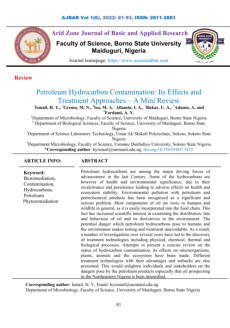

Authors:
W. Corredor-Santamaría, I.C. Calderón-Delgado, Z. Arbeli,
J.M. Navas, Y.M. Velasco-Santamaría Petro.
Polycyclic aromatic hydrocarbons are present in all
environmental matrices. Polycyclic aromatic hydrocarbon-
rich wastewater from the oil industry is discharged into
natural water bodies. Detritivorous fish show the effects of
pollutants in water. Biomarkers of effect make it possible to
demonstrate exposure to xenobiotics such as polycyclic
aromatic hydrocarbons. The present study aimed to
evaluate the hepatic and erythrocyte response in
Aequidens metae, an etritivorous fish exposed to polycyclic
aromatic hydrocarbons in terms of morphological,
biochemical, and genotoxic changes.


.


Authors: Wan Nor Roslam Wan Isahak, Lina
Mohammed Shaker, and Ahmed Al-Amiery
Once fundamental difficulties such as active sites and
selectivity are fully resolved, metal-free catalysts such as 3D
graphene or carbon nanotubes (CNT) are very cost-
effective substitutes for the expensive noble metals used
for catalyzing CO2. A viable method for converting
environmental wastes into useful energy storage or
industrial wealth, and one which also addresses the
environmental and energy problems brought on by
emissions of CO2, is CO2 hydrogenation into
hydrocarbon compounds.


.


Authors: Martyna A. Rzetala, Robert Machowski,
Maksymilian Solarski, Daniel Bakota, Arkadiusz
Płominski, and Mariusz Rzetala
The bottom sediments were studied within the basins of
water bodies used for recreational purposes (e.g., bathing,
fishing, and diving) in the Silesian Upland and its periphery
in southern Poland. It was found that bottom sediments
were contaminated to varying degrees with toxic metals,
metalloids, and non-metals, as evidenced by the values of
geoecological indicators. It was concluded that the
presence of harmful elements (e.g., lead, zinc, cadmium,
chromium, strontium, and arsenic) in bottom sediments
should be considered when classifying water bodies as
suitable for recreational use.


.


Authors: Michail Ragkousis, Maria Sini, Nikoletta
Koukourouvli, Argyro Zenetos,and Stelios
Katsanevaki.
The Greek Seas are extensively exposed to the proliferation
of marine alien species. At least 242 alien species have
been reported while their introduction rate is increasing.
Some species severely impact native ecosystems. The
spatio-temporal proliferation of these species outside their
natural boundaries depends on several parameters,
including their biological characteristics, native distribution
range, introduction pathway, and time of initial
introduction. Knowing the current and potential alien
species distribution is essential for implementing effective
management actions.


.


Authors:
Cecilia Paula Alonso, Mariano Rodríguez, Cintia Fraysse,
Gustavo Lovrich, and Gregorio Bigatti
Underwater sampling must balance time-efficient and
standardized data to compare areas and times. The roving
diver survey involves divers meandering and actively
searching for species and has been useful for producing
fish species lists but has seldom been implemented for
benthic taxa. In this study, the authors used this non-
destructive technique to register species associated with
kelp forests at the sub-Antarctic Bécasses Island (Beagle
Channel, Argentina), detecting numerous species while
providing the first multi-taxa inventory for the area.


.


Authors: Central mediterranean Sea - Threatened by
Anthropogenic Impacts (Michela Angiolillo,
Michela Giusti, Lorenzo Rossi, and Leonardo
Tunesi
This study reports the first attempt to quantitatively
describe a Dendrophyllia ramea population on the Apollo
bank (Ionian Sea), revealed in summer 2021 through a
remotely operated vehicle (ROV) survey. The habitat
description, bathymetric distribution, population density,
and structure of the species were assessed by image
analysis.


.


Authors:
M. Riedel, M. Scherwath, M. Römer, C. K. Paull, E. M.
Lundsten, D. Caress, P. G. Brewer, J. W. Pohlman, L. L.
Lapham, N. R. Chapman, M. J. Whiticar, G. D. Spence, R. J.
Enkin, and K. Douglas
Barkley Canyon is off the west coast off Vancouver Island,
British Columbia, Canada. The authors combined repeat
remotely operated vehicle (ROV) sea floor video
observations, mapping with an autonomous underwater
vehicle (AUV), ship-, ROV-, and AUV- based identification
of gas flares, as well as seismic and Chirp data to
investigate the distribution of fluid migration pathways.


.


Authors: O. V. Soloveva, E. A. Tikhonova, K. I. Gurov, E.
A. Kotelyanets
The present environmental problems of Balaklava Bay
(Black Sea), which has an increased anthropogenic load
for a long time, are of growing interest.
It is known that high concentrations of hydrocarbons
(HCs) negatively affect the life processes of hydrobionts.
The purpose of this work is to determine the content and
spatial distribution of HCs as well as to assess the possible
sources of their input in the bottom sediments of Balaklava
Bay.


.


Authors: Rod M. Connolly, Kristin I. Jinks, Cesar Herrera,
and Sebastian Lopez-Marcano
Mobile underwater cameras, diver-operated or on
underwater vehicles, have become popular for
monitoring fisheries. Replacing divers with cameras
has clear advantages, such as creating permanent
records and accessing waters unavailable to divers.
The use of cameras, however, typically produces large
quantities of video that are time-consuming to process
manually. Automated analysis of underwater videos
from stationary cameras using deep learning
techniques has advanced considerably in recent years,
but the use of mobile cameras potentially raises new
challenges for existing methods.


.


Authors: Maria Bollinger, Keir J. Macartney, Erin E.
Easton, and David W. Hicks
On the continental shelf off the coast of South Texas lie a
series of natural hard-bottom structures (rocky outcrops
and relic coral-algal reefs) known as the South Texas
Banks (STB), which provide critical habitat for benthic
organisms and pelagic fish. The depth of the banks, a
persistent nepheloid layer, and strong currents have
resulted in few studies that provide quantitative
biodiversity data on the STB. Using a remotely operated
vehicle (ROV), video surveys were conducted to
quantitatively describe the mesophotic coral communities
and assess habitat suitability of fiveve STB


.


Authors:
Mackenzie E. Gerringer, Yumna Ismail, Kayla A. Cannon,
Arline Camilo Hernandez, Franchesca Gonzales Peralta,
Ryan Bohen, Joseph C. Cartwright, Austin Feasley, Lydia
Fregosi, Hannah Lehman, Hailey Niles, Jillian Quay, Nima
Sherpa, Brett H. Woodworth, and Kasey Cantwell
Access to deep-sea systems has been expanded by
programs such as the National Oceanic and Atmospheric
Administration's Ocean Exploration (NOAA Ocean
Exploration), which uses telepresence to bring deep-sea
exploration to a global audience. The authors of this
paper present an example of how remotely operated
vehicles can engage students in original research.


.


Authors:
Tadamichi Morisaka, Tomo Furuichi, Kazunobu Kogi,
Motoi Yoshioka
The authors propose a group definition for underwater
observations after comparing 234 group transitions from
44 surveys of simultaneous boat-based and underwater
observations targeting the resident Indo-Pacific bottlenose
dolphins around Mikura Island, Japan.


.


Authors:
Daniel Ierodiaconou, Dianne McLean, Matthew Jon Birt,
Todd Bond, Sam Wines, Ollie Glade-Wright, Joe Morris,
Doug Higgs, and Sasha K. Whitmarsh
This study uses a decade of industry remotely operated
vehicle (ROV) imagery to describe fish, invertebrate, and
benthic communities on gas field infrastructure. Sampling
was conducted over 22 km of flowline, three wells and
one manifold in the temperate waters of Bass Strait, south
east Australia in depths of 155 to 263 metres.


.
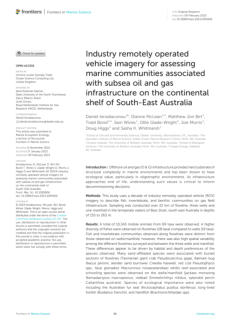

Authors:
Kirsten F. Thompson, Kathryn A. Miller, Jake Wacker,
Solène Derville, Christopher Laing, David Santillo, and Paul
Johnston
Deep seabed mining operations, if permitted, could
present significant risks to ocean ecosystems. Disturbance
on any scale is likely to be long lasting and irreversible.
Scant research to date has examined the impact that deep
sea minerals extraction would have on cetaceans.


.


Authors:
Leigh W. Tait, Jeremy Bulleid, Lily Pryor Rodgers, Kimberley
Seaward, Louis Olsen, Chris Woods, Henry Lane, and
Graeme J. Inglis
The authors assessed the sensitivity and efficiency of ROVs
and divers for detecting marine non-indigenous species
(NIS), including the potential for automated detection
algorithms to reduce post-processing costs of ROV
methods.


.
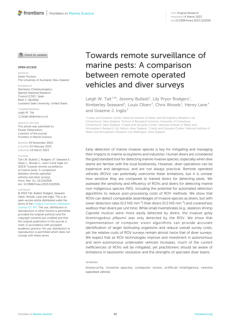

Authors:
Delphine Lobelle, Li Shen, Bas van Huet, Tim van Emmerik,
Mikael Kaandorp, Giulia Iattoni, Cornelius Peter Baldé, Kara
Lavender Law, and Erik van Sebille
Plastic entering the environment is a growing threat for
ecosystems. the authors estimate the annual mass of
known Dutch plastic waste generated and littered and
where it ends up. The author used two methods: a
material flow analysis of plastic waste separately collected
from 13 economic sectors, and estimate the amount sent
to processing plants or exported and a mismanagement
model from observations of litter plus estimates of
inadequately managed exported plastic scraps entering
the environment abroad.


.


Authors:
Maximilian P. Born,* Catrina Brull, and Holger Schuttrumpf
Studies investigating different effects on the fragmentation
of plastics have mostly disregarded a sufficient mechanical
component for fragmentation, focusing on degradation
by UV radiation. Therefore, this study investigated the
impact of the mechanical fragmentation drivers, wave
impact, and sediment abrasion on the fragmentation of
expanded polystyrene (EPS), high-density polyethylene
(PE-HD), and polyethylene terephthalate (PET) particles


.




.
Author: Safia Akli-Bidi
Eucyclops are small crustaceans that are important
members of aquatic food webs. Examination of Eucyclops
populations coming from Algerian water bodies and
identified as Eucyclops cf. serrulatus showed three
morphotypes 1, 2 and 3, based on the morphometric
characters and the microcharacters. The morphotype 1
was the most abundant, collected in the East and the
West of Algeria. The morphotype 2 was sampled in the
south of the country, characterized by posterolaterally
elongated thoracic segments and the fourth thoracic
segment has cilia on its lateral angles. The morphotype 3
was found in a small temporary pond in the north and
was the smallest one.


Author: So Gu Kim
Most underwater explosions show characteristics of a
bubble pulse and reverberation effects. To specifically
identify the cause of an underwater explosion, it is most
important to find a bubble pulse and reverberation effects
using spectral and cepstral analyses. For a very shallow
underwater explosion, spectral analysis is preferable to
cepstral analysis. Time-domain analyses show bubble
pulses as well as positive polarities of the first P-wave
arrivals on the vertical component, and frequency-
domain spectral analyses also clearly reveal the bubble
pulse and reverberation effects. This study includes
comparative studies including a Russian underwater
nuclear explosion and US Navy shock trials.


.


Authors:
Luca Andolfi, Mirko Antonini, Stefano Binda, Paolo Braca,
Luciano Bozzi, Sandro Carniel, Nicola Forti, Giorgio
Ioannou, Elizabeth Laier English, Margherita Lenoci,
Leonardo M. Millefiori, Alfredo Renga, Aniello Russo,
Giuseppe Tomasicchio
Although satellites are very accurate in monitoring the
melting glaciers, they provide scarce or no information
about under-ice water characteristics. However, mobile
platforms would represent a substantial integration of the
Ice Tethered Profilers, which move slowly with the sea ice
without possibility to select the specific area where the
data are collected. This paper givies an overview on how
capabilities provided by underwater Positioning,
Navigation and Timing (PNT) technologies can support
Climate Change Monitoring.


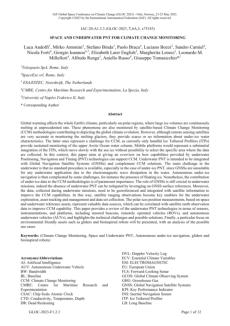

Authors: Carlotta Sacco Perasso, Federica Antonelli,
Barbara Calcinai, Edoardo Casoli, Maria Flavia
Gravina, and Sandra Ricci
Bioerosion is the destruction of hard substrates resulting
from biological activity, and plays a relevant role in the
ecological interactions and coastal dynamics processes.
Several organisms have evolved structures and behaviors
allowing them to perforate biotic and abiotic surfaces,
transforming hard surfaces into particles, and contributing
significantly to sediment production in the coastal and
marine environment. Due to the large geographical
diffusion of marine borers, bioerosion is relevant in many
scientific and applied fields of interest.


.


Authors:
Virginia Biede, Andrew R. Gates, Simone Pfeifer, Jane E.
Collins, Carmen Santos, and Daniel O. B. Jones
Large structures are introduced into deep-water marine
environments by several industrial activities, including
hydrocarbon exploitation. Anthropogenic structures can
alter ecosystem structure and functioning in many marine
ecosystems but the responses on continental margins are
poorly known. The authors investigated the short-term
response of benthic megafauna to the installation of a 56
km-long 30 cm diameter pipeline on the Angolan Margin
(Block 31) from 700 to 1800 m water depth using
remotely operated vehicle imager


.


Authors: Hailey L. Davies, Shane Gross, Dana R.
Haggarty, Francis Juanes
Rockfishes are a diverse group of fish in the order
Scorpaeniformes that are distributed globally but
concentrated in the North Pacific. Recognizable by their
large eyes and distinct dorsal spines, the genus is united
by shared characteristics including live births, head spines,
a highly spinous dorsal fin succeeded by a soft- rayed
portion, and musculature attached to a closed
(physoclistous) swim bladder.


.


Authors:
Maciej Liro, Tim H.M. van Emmerik, Anna Zielonka, Luca
Gallitelli, Florin-Constantin Mihai
Mountain rivers are typically seen as relatively pristine
ecosystems, supporting numerous benefits for human
populations living not only in the mountain regions but
also downstream from them. However, recent evidence
suggests that mountain river valleys in populated areas
can be substantially polluted by macroplastics (plastic items
>25 mm). To stimulate future work on this gap, the
authors present a conceptual model of macroplastic
transport pathways through mountain rivers.


.


Authors: Maciej Liro, Anna Zielonka, Tim H.M. van
Emmerik
The process of macroplastic fragmentation results in the
production of plastic particles, which threaten biota and
human health and are difficult to remove from the
environment. The global coverage and long retention
times of macroplastic waste in fluvial systems, ranging from
years to centuries, create long-lasting and widespread
potential for its fragmentation and the production of
secondary micro- and nanoplastics. However, the
pathways and rates of this process are mostly unknown,
and existing experimental data is not fully informative,
which constitutes a fundamental knowledge gap in our
understanding of macroplastic fate in rivers and the
transfer of produced microparticles throughout the
environment.


.




.
Authors: Cristina Galobart, Enric Ballesteros, Raül Golo,
and Emma Cebrian
Active restoration actions are becoming increasingly
common for the recovery of degraded ecosystems.
However, establishing when an ecosystem is fully restored
is rarely achieved, since the recovery of entire communities
requires long-term trajectories. The lack of evidence of
success is even more severe in marine ecosystems,
especially in the context of macroalgal forests, where,
beyond the vegetation structure and species diversity,
there is no approximation to determine the recovery of
the overall functionality.
The authors used a trait-based approach to assess the
recovery ten years after the initiation of a restoration
action in a marine macroalgal forest.
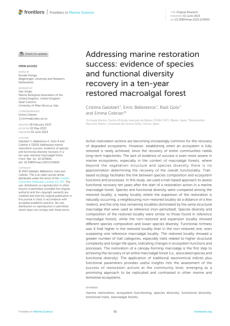

Authors: Pranali Roy Chowdhury, Malay Banerj
Sergei Petrovskii
Deoxygenation of the ocean often results in the formation
of Oxygen Minimum Zones (OMZ): large domains where
the abundance of oxygen is much lower than that in the
surrounding oceanic environment. Factors and processes
resulting in OMZ formation remain controversial. The
authors propose a conceptual model of coupled plankton-
oxygen dynamics that, apart from the plankton growth
and oxygen production by phytoplankton, also considers
the difference in timescales between phyto- and
zooplankton.


.


Authors: Rui He, Lijun Dong, Xiaomei Xu, Apostolos
Tsouvalas
Offshore wind energy is environmentally friendly for
humans, but it may not be so for aquatic life. Underwater
noise and seabed vibrations are generated during the
construction, maintenance, operation and
decommissioning of offshore wind farms. The potential
impact of the generated noise and the seabed vibrations
on aquatic species may hinder the further deployment of
offshore wind farms and marine ranching.


.


Authors: J. R. Kerr, P. R. White, T. G. Leighton, L. G. M.
Silva, & P. S. Kemp
The expansion and potential rupture of the swim bladder,
which to rapid decompression, a major cause of
barotrauma injury in fish passing through turbines and
pumps. It is generally assumed to be governed by Boyle’s
Law. In this study, two swim bladder expansion models
are presented and tested in silico.


.
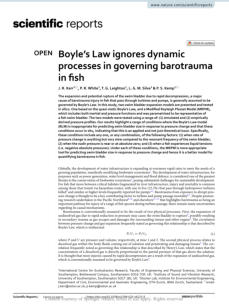

Authors: Heiðrikur Bergsson, Morten Bo Søndergaard
Svendsen, and John Fleng Steffensen
To ensure optimal feed intake, growth, and general fish
health in aquaculture sea cages, interactions between
drivers that affect oxygen conditions need to be
understood. The main drivers are oxygen consumption
and water exchange, caused by flow through the cage.
Swimming energetics in rainbow trout (Oncorhynchus
mykiss) in normoxia and hypoxia at 10, 15, and 20 C
degrees were determined. Using the determinations, a
conceptual model of oxygen conditions within sea cages
was created.


.




Click on the
octopus to return to
the top of the page

Author: Valeri V. Lenchine
Many marine infrastructure projects increase
environmental impact during the construction and
operational phases due to excessive noise. The lack of
standardized methods for assessing and predicting
underwater noise increases the risk of adverse changes to
the marine environment. This study reviews methods for
modeling the impact of underwater noise as part of
marine project planning and identifies the need for noise
mitigation measures.


.


Authors: Rene Smidt Lutzen, Søren Keller, & Jakob
Tougaard
Since 2016, guidelines from the Danish Energy Agency
have addressed underwater noise from offshore wind
farm construction in Danish waters. The guidelines were
updated in 2022 to include technical methods for
numerical prognosis and on-site measurements.
Compliance is determined based on acoustic criteria such
as Permanent Threshold Shift (PTS) and behavioral impact.
Auditory frequency-weighted levels are used as the basis
for these criteria.


.


Authors: Aude Benhemma-Le Gall, Paul Thompson,
Nathan Merchant, Isla Graham
The expansion of offshore wind farms overlaps with
protected marine mammal habitats, and there are
concerns for small cetaceans, such as harbor porpoises,
due to the potential for injury from impulsive noise during
turbine foundation installation. Current risk assessment
methods compare predicted noise levels with estimates of
baseline animal density. However, pre-piling activities may
displace animals, potentially reducing the risk of injury.


.

Authors: Amar Prakash Kaushik, Vivek Kumar Himanshu,
M.P. Roy, A.K. Mishra, Ashish Mishra, and Huzaifa
Sufiyan Siddique
This article outlines the core elements of underwater
drilling and blasting operations. It highlights the enduring
constraints and obstacles, underscoring the need for
continued investigation and understanding.


.



Authors: Darshika Manral, Ilse Bos, Mark de Boer, Erik van
Sebille.
Juvenile Kemp's ridley turtles, a critically endangered
species mainly living in the Gulf of Mexico, strand on the
Dutch coasts every year. This study examines several
instances over the last 15 years where juvenile turtles were
found alive but hypothermic during winter in the
Netherlands to understand how they were transported in
this state.


.












